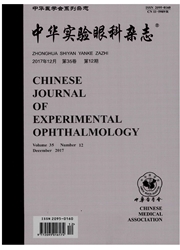

 中文摘要:
中文摘要:
目的探索异种角膜脱细胞基质和几丁糖为载体构建生物角膜组织的可行性,评价二者的结构、功能和生物相容性。方法l%TritonX-100及冷冻干燥处理获得猪角膜脱细胞基质,网状几丁糖材料制备成似角膜片状形态,将体外培养的兔角膜基质细胞种植于两种载体,体外培养2周,形成细胞载体复合物。对构建的角膜组织进行苏木精-伊红染色、扫描电镜观察;同时将两种生物材料移植到兔角膜基质囊袋内,观察其生物相容性。结果角膜基质细胞在两种载体上皆可黏附生长,并分泌细胞外基质。脱细胞基质载体内细胞形态不规则,位于胶原板层间,形成类似正常组织的角膜基质结构;细胞可在几丁糖网状纤维上黏附并包绕生长。两种载体移植到兔角膜囊袋后,脱细胞基质降解较慢,与宿主角膜组织相融性良好,未发生明显排斥及毒性反应;几丁糖载体降解较迅速,但降解产物诱导较严重的排斥反应。结论异种角膜脱细胞基质保留正常组织的胶原板层结构,并具角膜的韧性和良好的生物相容性,更适于作为体外构建生物角膜的载体,而几丁糖材料则需要在构成结构和性能等方面进一步改进.
 英文摘要:
英文摘要:
Objective Ideal carrier material is very important for construction of cornea. It is required to have good biocompatibility, three-dimensional structure, be biodegradable and suitable to the adhesion, growth, proliferation and differentiation of cells. This study was to investigate the feasibility of reconstructing corneal stroma with porcine corneal acellular matrix and chitosan as the scaffold and compare their structure, function and biocompatibility. Methods Porcine cornea processed by detergent 1% TritonX-100 and freeze-drying was prepared as acellular matrix,and chitonsan scaffold was made into the shape of cornea. Cultured rabbit keratocytes were seeded into porcine corneal acellular matrix and chitosan scaffold respectively. After 2 weeks of culture, the histological structure of the cell-scaffold constructs was examined by HE staining and scanning electron microscope. At the same time,two kinds of carriers were transplanted into rabbits' corneal sac to evaluate their rejection and compatibility. Results Corneal keratocytes could adhere, proliferate and excrete extra cellular matrix on both kinds of carriers. In acellular matrix,growing cells were similar to the normal corneal stroma among the collagen lamellar; while in the chitosan,spindle cells grew around each fiber. After transplanted into the rabbit corneal stroma, acellular matrix showed slow degradation and integrated with rabbit cornea gradually, and keratocytes from recipient immigrated into the transplanted matrix. Chitosan had a relative rapid degradation and appeared rejection,showing new blood vessel and serious inflammatory reaction. Conclusion Xenogenic corneal acellular matrix possess the structure of corneal collagen lamellar with tenacity and biocompatibility,so it is more feasible to be used as a scaffold for tissue engineered cornea. However, further recombination and refinement are need for chitosan carrier.
 同期刊论文项目
同期刊论文项目
 同项目期刊论文
同项目期刊论文
 期刊信息
期刊信息
